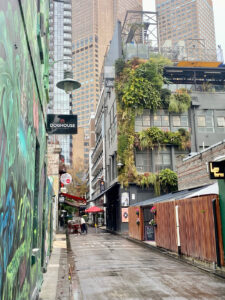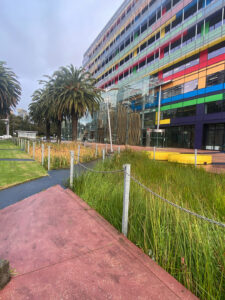The greener the street, the greater the asset
By Michael Casey
In most cases, when the term green infrastructure is used in a planning and design context, by default most of us think about green roofs, walls and facades but what about the many other applications that can be used to ensure built environments are designed with the inclusion of plant life.
The CSIRO refers to urban green infrastructure (GI) as “all of the vegetation that provides environmental, economic and social benefits such as clean air and water, climate regulation, food provision, erosion control and places for recreation. GI includes urban parks and reserves, wetlands and stream corridors, street trees and roadside verges, gardens and vegetable patches, bikeways and pedestrian trails, wall and rooftop gardens, orchards and farms, cemeteries and derelict land”.
This article will explore the need for greening streetscapes and where these street spaces can be successfully turned into ‘green streets’, giving them back to communities that once used these as an extension of their own household space.
Through my recent work and experience in designing ‘greening streets’ for an inner-city Melbourne project (which has been referred to in previous articles), I’ve concentrated on turning open spaces such as council-owned nature strips and street verges within an inner-city residential suburb, into useable green spaces that will adopt numerous greening techniques to further benefit the surrounding community.
Whilst this approach isn’t unique, it can only eventuate when communities and forward-thinking councils collaborate to turn streets back into places that children and families can feel safe in, where people can walk/exercise and where residents can socialise and move freely around, which is especially beneficial for those who have limited household space.
Imagine a tree lined street with gardens, seating for passive use, families walking freely along extended footpaths, children riding bikes without fear of speeding cars. I appreciate this may be painting a picture of extreme optimism, and may possibly be unrealistic to presume we might have carless streets and that people will occupy these spaces. For some locations, with the right strategies and good design, this will help inform how we can better design streetscapes and spaces and therefore better manage these assets. Just imagine streets where walking and bike riding and passive activities were prioritised at certain times of day or weekends, over cars and other vehicles.

“If you plan cities for cars and traffic, you get cars and traffic. If you plan for people and places, you get people and places.”
Placemaking, the process of creating quality places that people want to live, work, play and learn in, has inspired and motivated people to jointly reimagine and reinvent their public spaces as the heart and soul of their community. Some current examples of this joint work can be seen in the many examples around the world and in our local capital cities. In Melbourne, where I mostly work, I see varied examples of where communities and councils have started the process of transitioning streets into green spaces.
Hobson Bay in Melbourne’s southwest has developed their ‘The Green Streets’ program which is a collaboration between council and the community, to green residential streets through urban design solutions and education.
The City of Yarra have their ‘Local Liveable Streets’ initiative which is designed to improve the amenity and resilience of streets, so they can continue to support their communities in years to come. The city’s document also states that “Local streets are an important part of the public realm. They are the public ‘face’ of every area and the doorstop to people’s homes and businesses. Most importantly, they are the places in which people connect and interact.”
The City of Melbourne states “many of our laneways have enormous potential to become the city’s backyard and with over 200 laneways throughout the central city that equates to close to nine hectares of potential green spaces”. The program the City of Melbourne developed includes a “world-first interactive map to show laneways that could go green, based on the amount of sunlight they receive, exposure to wind and physical characteristics.”
Our close neighbours in southeast Asia have been implementing ideas like this for some time, with examples in both Singapore and India.
Singapore has been active in recognising the importance of green spaces across their country and the need to enhance walkability within their communities, along with connecting them easily to nature. By creating the ‘Park Connecting Network’, Singapore has been able to provide comfortable, attractive and convenient green mobility corridors for people to walk, cycle and run along. These corridors, now covering over 300kms, link open spaces, transport hubs, commercial centres and residential zones alleviating footpath and road traffic.
Prune, India, has created their ‘Urban Street Design Guidelines’ that focus on a pedestrian-first approach, ensuring all new infrastructure is ‘people focused’ and developed to a high and safe standard.
Identifying, understanding and communicating the benefits of green streets are needed to be able to inform the design and implementation of green infrastructure assets into our communities. A well thought out and designed green street will assist with improving passive and active outdoor activities, assist with storm water mitigation and increase biodiversity. Additionally, more readily measured outcomes will be realised though the social, environmental, and economic impacts.

Social benefits such as, creating a more aesthetically pleasing streetscape and community, and the promotion of outdoor activities. The environmental benefits include improved air filtration, provision of habitats, reduction of surface temperatures and noise. On the economic front, this can translate to an increase in rental and property prices, a reduction in heating and cooling costs and the protection of impervious surfaces.
With all this in mind, what needs to be considered when planning and designing these spaces alongside the aesthetic design elements? As a starting point, it’s the needs of the people and their communities that are paramount. When people enjoy staying in a particular and familiar place and when socialising with neighbours, they tend to not venture too far away from their homes. With the additional options that can be incorporated into a street, and with a greater user experience, the more people in turn will be attracted.
Streets and suburbs attracting larger amounts of users equates to a safer space. Cars, in most cases, prove to be the biggest threat to street users and when larger numbers are using these spaces, the requirement for slower and more careful driving tends to follow. Streetscape designers should consider the entire landscape including all aspects, which unfortunately can often be overlooked.
By encompassing all of the ‘obvious’, as well as the less observable design features into one landscape, the objective is that people will choose green streets with multiple interest points over standard roads.
Businesses located in these street spaces also have the ability to benefit from green streets as users tend to feel relaxed in spaces they are comfortable in. Cafes, restaurants and the like can capitalise on green streets by setting up social drinking and eating areas in amongst these greener spaces, to create a more unique experience that cannot always be captured inside their business location. What better way than to enjoy a meal or a drink, while sheltering in the shade of a tree during hot weather!
As time goes on and as the benefits of additional green streets are heightened at a local and international level, it’s evident that they can be created to capture their own unique needs and identity. They can also share in places of history, culture, values and assets, along with providing a place where communities can feel connected and where they are happy to immerse themselves in and showcase to others. A sense of ownership, pride and a closer connection to nature is what’s also on offer.
Michael Casey MAIH RH
Director of Evergreen Infrastructure and MJC Horticulture,
National President of Australian Institute of Horticulture
Advisor to the green infrastructure industry
